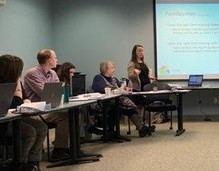Testing New Technology for Child Abuse Reporting
Project Description: In 2018, the Children's Bureau awarded a 3-year grant to Childhelp for the Prevent Abuse of Children Text and Chat Hotline (PACTECH) project. The purpose of this project is to identify best practices for using text and chat features in child abuse reporting and resource sharing. Childhelp is collaborating with Arizona State University's Southwest Interdisciplinary Research Center for the research and evaluation elements of the project.

Project Highlight: The project released a report presenting findings from its pilot phase. During the next phase, the PACTECH project will begin full implementation, which includes additional marketing to enhance awareness of the chat and text features.
Learn More: Visit the Childhelp website to learn more about the organization, including how you can volunteer and spread the word.
Photo provided by Childhelp
|
Developing and Training Foster and Adoptive Parents
Project Description: The Children's Bureau awarded a 3-year grant in 2016 to Spaulding for Children for the CORE (Critical Ongoing Resource family Education) project. Through this project, Spaulding for Children developed a state-of-the-art training program to equip resource parents with the skills necessary to meet the needs of older youth with moderate to serious emotional and behavioral health challenges.

Project Highlight: The project designed the CORE Teen Curriculum for both prospective and current families to help them support older youth from the child welfare system with emotional or behavioral challenges. The pilot curriculum, which included three components (a self-assessment, a classroom curriculum, and a training), addressed eight themes through a 25-minute video reflecting stories from youth, resource families, and content experts.
Learn More: For additional information about this project, visit the Spaulding for Children website.
Photo provided by Spaulding for Children
|
Creating Workforce Solutions With Human Resources
Project Description: The University of Nebraska-Lincoln received a 5-year grant from the Children's Bureau in 2016 to create a Quality Improvement Center for Workforce Development (QIC-WD). The QIC-WD was designed to conduct a multisite demonstration project to address pervasive child welfare workforce challenges and to test innovative and promising workforce improvement strategies.

Project Highlight: The QIC-WD invites you to apply to participate in a short-term Child Welfare Workforce Analytics Institute. The goal of the institute is to build and strengthen partnerships between child welfare and human resource professionals and discuss how to leverage data necessary to examine and address workforce challenges. The call for applications is available here. The deadline to apply is February 14, 2020.
Learn More: Watch the QIC-WD video to hear about eight child welfare systems selected to test workforce strategies.
Photo provided by the QIC-WD
|
Establishing Community Court Teams to Meet Families’ Needs
Project Description: The Children's Bureau awarded a 3-year grant in 2017 to Children and Family Futures for the National Quality Improvement Center for Collaborative Community Court Teams (QIC-CCCT). The QIC-CCCT funds demonstration sites to establish collaborative community court teams to design, implement, and test approaches to better meet the needs of infants and families affected by substance use disorders and prenatal substance exposure.

Project Highlight: The QIC-CCCT selected 15 demonstration sites in 2018. A 2019 program summary describes how the sites are serving infants with prenatal substance exposure and their families, proposed implementation strategies, and expected goals and outcomes.
Learn More: Visit the QIC-CCT website to read more about the demonstration sites and more.
Photo provided by Children and Family Futures
|
|